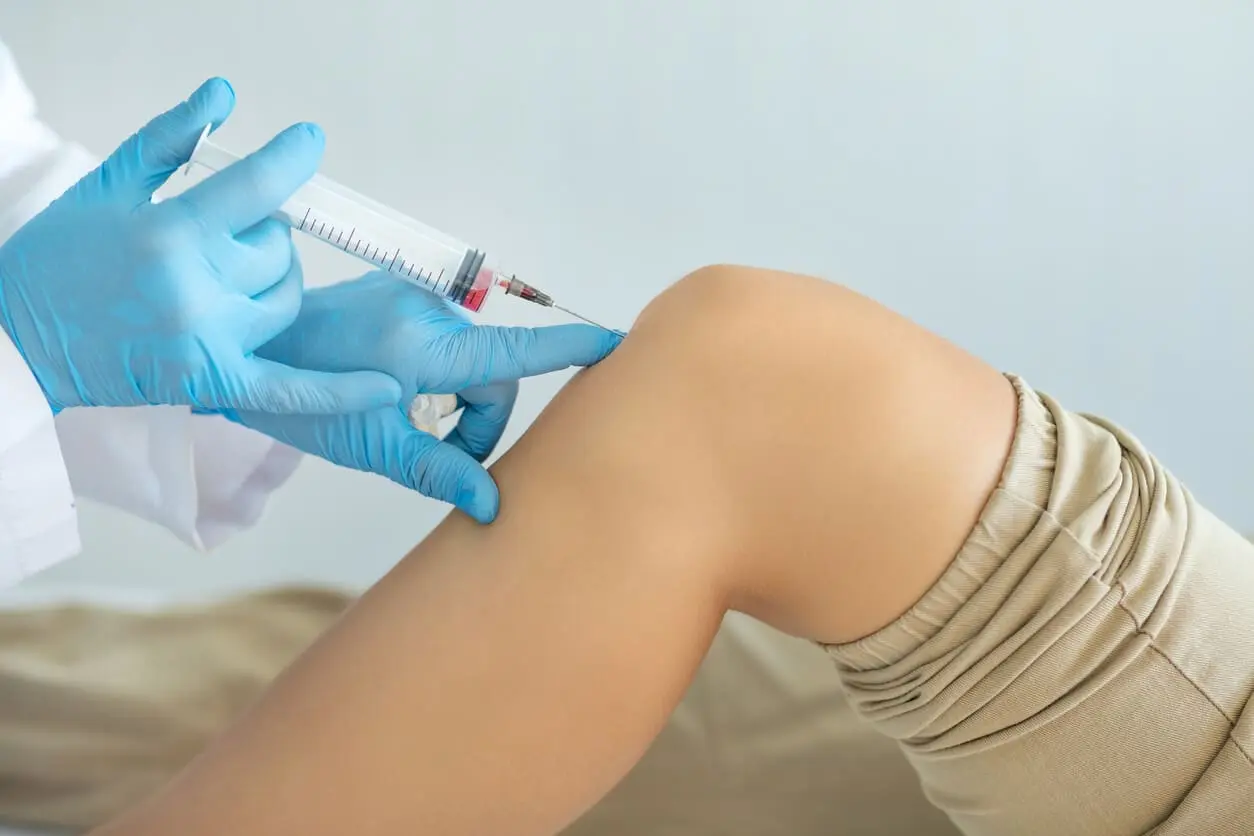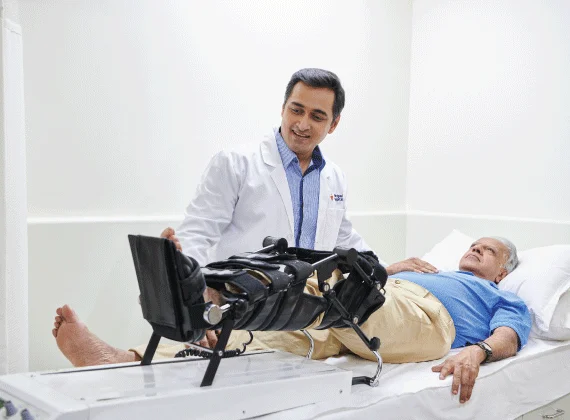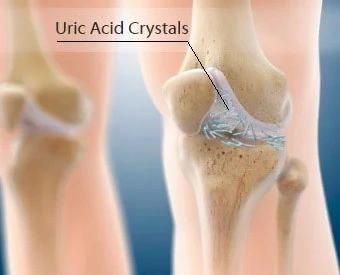The Latest on Knee Lubricant Injections: Are They Right for You?
Knee lubricant injections, also known as viscosupplementation, have emerged as a therapeutic option for individuals suffering from knee osteoarthritis (OA).
Osteoarthritis is a problem that affects people who have knee pain all the time. Osteoarthritis is a degenerative joint disorder, as opposed to the temporary pain and inflammation that a strong immune system reaction might cause in a joint.
Arthritis in the knees could be treated with injections of a lubricating fluid that looks natural and develops in joints. Viscosupplementation can be an option if you’ve tried all nonsurgical therapy options and the pain still stops you from doing the things you like doing.
Introduction
One of the main conditions that cause damage to the knee joint is osteoarthritis. The pain that it causes gets worse over time as it slowly develops. Given the fact that osteoarthritis has no known cure, many therapeutic choices can help patients manage their pain and continue their active lifestyles.
Knee arthritis is treated nonsurgically when it first appears. Your doctor might suggest a variety of therapies, such as:
- Modifying your activities
- loss of weight
- Nonsteroidal anti-inflammatory medications (NSAIDs) like ibuprofen and acetaminophen are examples of pain relievers.
- Exercise therapy
- Injectable corticosteroids
When osteoarthritis, often known as “wear-and-tear” arthritis, the cartilage cap breaks. This leads to the unnatural scratching of the bones in your joints. In patients with osteoarthritis, hyaluronic acid levels in the joints are frequently lower than normal. All of this causes edema, pain, and stiffness as symptoms. The idea behind viscosupplementation is that by adding more hyaluronic acid, symptoms should be reduced.
The process of viscosupplementation also referred to as hyaluronic acid or hyaluronan injections involves injecting hyaluronic acid, a lubricating fluid, into the knee. Healthy knees already have hyaluronic acid in their joint fluid, but osteoarthritis-affected joints have reduced levels of this component.
How the knee is helped by viscosupplementation;
- Relieve pain
- Reduce rigidity
- Improve your range of motion
Also, viscosupplementation’s ability to reduce pain may make it simpler to follow a rehabilitation program that includes mild, gradual knee exercises. exercises that could have been difficult to perform before injection.
Not every kind of joint can benefit from hyaluronic acid injection therapy for arthritis. The usual injection site is the knee, but you may also be able to have it for the hip or maybe other types of arthritis.
Understanding About Arthritis in the Knee:
The medical term for joint inflammation is “arthritis.” It lists more than a hundred related diseases with comparable symptoms. These include pain in the joints, stiffness, and edema.
Degenerative joint disease, also referred to as osteoarthritis, is the most common type of arthritis. It happens as a result of a loss and degradation of the protective cartilage at our bone points. Bone-on-bone contact can result in pain, edema, and other symptoms.
The knees and hips are two common weight-bearing joints affected by osteoarthritis. It is commonly known as knee osteoarthritis, or knee OA when it affects the knee joint.
Although the symptoms of osteoarthritis (OA) appear slowly, they usually get worse with age. Early on, over-the-counter drugs like ibuprofen might help you control your pain. However, this kind of medication may not be as effective if your cartilage gets worse further.
Knee joint lubrication:
In general, the synovial fluid that lubricates the knee joint allows smooth bone movement in a way similar to that of oil. However, in those with osteoarthritis, the articular fluid becomes less concentrated and flexible due to hyaluronic loss, cartilage, and degeneration of the articular surface. causing pain when moving, edema, inflammation, and joint pain.
What Are Knee Pain Relief Lubricant Injections?
If you’re tired of dealing with knee pain caused by arthritis or joint inflammation and you’ve been told that your only alternatives are surgery or joint replacement, there are several still nonsurgical options to think about.
Viscosupplements come in a variety of brands, such as Euflexxa, Synvisc, Hyalgan, Supartz, Gelsyn, Triluron, and Orthovisc. There are slight differences between these products in terms of viscosity, the amount of injection required, and hyaluronic acid content.
These injections work best in the knee, hip, ankle, and shoulder, although they can be utilized in practically every joint. For hyaluronic acid to have positive results, it must be inserted into the joint properly.
Knee Osteoarthritis Injection Treatment:
If you are not yet suitable for knee replacement surgery but alternative therapies are not working, your doctor may recommend knee injections. Medication or another chemical is directly injected into your knee joint.
- Injection corticosteroids:
Corticosteroid injections are a kind of medication that decreases inflammation and pain. They are sometimes referred to as steroid shots or cortisone shots. They may offer quick relief from pain, edema, and stiffness when injected into the knee. Some people experience weeks-long results. For six months or more, others might feel relief.
Insulin injections are available in two forms: extended-release (Zilretta) and short-acting (triamcinolone acetonide). Zilretta might offer relief that lasts three months longer than other treatments.
- Injections of platelet-rich plasma:
Blood’s liquid component is called plasma. After a cut, platelets, which are little blood cells, stop the bleeding and release growth factors that help in the healing process. Plasma that has more platelets is known as platelet-rich plasma (PRP).
Your doctor takes a sample of your blood, mixes it in the lab to increase the quantity of platelets, and prepares platelet-rich plasma. Next, the platelet-rich plasma is injected into the knee joint.
- Injections of autologous conditioned serum:
Another kind of injection created from your blood that has more anti-inflammatory chemicals is called autologous conditioned serum (ACS).
- Injections of stem cells:
Stem cells are the structural components of the body. Stem cells have the potential to regenerate healthy joints since they give rise to new cells and tissues.
- Injections of Hyaluronic Acid:
Hyaluronic acid injections (also known as viscosupplements). A healthy knee’s fluid supports the joint and reduces pressure. Hyaluronic acid is a chemical found in this fluid. It functions as a lubricant to prevent your bones from grating against one another. Less hyaluronic acid is frequently found in the knee joints of people with osteoarthritis. Hyaluronic acid injections are one way that doctors can help restore missing knee cartilage. For a few months, this could improve joint lubrication and reduce pain and swelling.
The synovial fluid contains hyaluronic acid, a naturally occurring chemical that lubricates the joint fluid and allows bones to move easily over one another. It also helps in reducing joint loads as a shock reliever. Sodium hyaluronate is one form that is present.
In their joints, people with osteoarthritis have less hyaluronic acid than usual. As the body’s natural joint fluid, hyaluronic acid is added to the arthritic joint through viscosupplementation for osteoarthritis of the knee to promote mobility and reduce pain.
Your doctor will assist you in selecting the best knee injection if you want to try one. Additionally, the doctor will make sure that you are aware of the advantages and disadvantages of injection therapies.
When should I apply knee lubrication?
The patient will be advised by the physician to lubricate the surface of the knee. patients with osteoarthritis who are in the middle stage or those who do not respond well to medication-based therapy. For those who have not undergone surgery as of yet. Fluid injection lubrication of the knee surface may last six months to a year, depending on the patient’s medical needs and the severity of the condition.
What should I do before having viscosupplementation treatment for arthritis?
Talk up all of your health problems with your medical doctor. Aspirin and other over-the-counter medications should be reported to the doctor who treats you together with all other medications you take. As directed by the doctor, take all of your medications as prescribed.
You are free to eat and drink as usual on the day of your treatment. Inform your physician of any recent symptoms, such as a fever. To make it easier to see your joint, you might wish to dress loosely. You may receive additional instructions regarding preparation for your surgery from the doctor who treated you.
Features of knee surface lubrication via fluid injection:
A liquid form of hyaluronic acid (HA), the primary component of normal vitreous fluid, is used as a lubricant for the knee surface. This is why the water lubricates the knee joint’s skin. It therefore has features with the natural tissues found in the body. Fluid injections can help in balancing and modifying the fluid content in the joints. This has anti-inflammatory effects that improve joint health. Knee replacement surgery may be postponed if this medication is used.
Process:
The injection site will be cleaned by the doctor who gave you the injection. You will receive one to five doses for many weeks, depending on the drug used.
To protect the area from discomfort or acute pain while the treatment is being performed, a doctor will typically inject a local anesthetic into the region surrounding your joint. Instead, a doctor may choose to use an anesthetic spray.
Your doctor can at times use imaging to make sure that the injection is made exactly where it is needed. Your doctor may use an ultrasound machine or another tool that displays X-rays regularly.
Before injecting the hyaluronic acid, your doctor may take in any extra fluid from your knee if there is any swelling during the surgery. One needle is often used for both the aspiration and the injection into the joint. However, some medical professionals might choose to use two different syringes.
During this process, the knee joint is injected with hyaluronic acid, a gel-like product. The synovial fluid that surrounds joints contains hyaluronic acid, It is a part of the structure. It acts as a lubricant to make it easier for bones to move over one another and as a support for joint loads.
Osteoarthritis patients’ joints contain lower-than-normal amounts of hyaluronic acid. Injections of hyaluronic acid into arthritic joints are meant to improve mobility and reduce pain.
You should stay away from intense physical activity, such as jogging or heavy lifting, for the first 48 hours following the injection.
Effects on other treatments:
Inform the doctors of all other medications you take before receiving a hyaluronan injection.
As some complementary therapies might react negatively with hyaluronan injections, never take herbal remedies or other complementary therapies without first consulting a doctor.
Before beginning hyaluronan injections, it is also advisable to talk about vaccinations with the doctors who treat you.
Before getting hyaluronan injections, inform the person treating you about all other medications you take. Notify any other doctors that you have recently had hyaluronan injections.
Side Effects:
Immediately following the injection, you can experience a local reaction that includes pain, warmth, and mild swelling. Usually, these symptoms go away quickly. To help relieve them, you might wish to use an ice pack.
Complications
In rare cases, patients may experience a knee reaction similar to a localized allergy. In these situations, the knee may swell, become red, heat up, and be painful. Please get in touch with your doctor right away if this happens.
Extremely rare side effects of this surgery include bleeding and infection.
What happens following viscosupplementation therapy for arthritis?
After your surgery, you have to be able to return home soon. Find out from a medical professional if driving is safe for you. You need to stay away from hard walking, jogging, lifting large weights, and prolonged standing for approximately 48 hours.
Some post-procedure patients experience mild pain, warmth, and swelling. Usually, these symptoms pass quickly. An ice pack could be useful. If you have significant warmth, redness, pain, or a high fever, or if these symptoms don’t go away quickly, Consult with a doctor right away. Observe all prescription and follow-up care recommendations from your doctor.
Remember to get ready for all of your upcoming appointments. If you do not receive all of the shots in the series, the operation might not be effective.
Your hyaluronic acid injection won’t likely make your symptoms go away right away. Several weeks could pass before you start to see results. You can see many months of symptom relief.
You might be able to repeat the injection (or series of injections) in about six months if viscosupplementation works for you. Not everyone benefits from the surgery, but. Continue to talk about alternative treatment options, such as joint surgery, with your healthcare doctor if the procedure is unsuccessful for you.
Rehabilitation:
Viscosupplementation may help treat knee osteoarthritis, however, it functions best when paired with other reliable methods.
The best responses from patients come when they also,
- Participate in aerobic exercise.
- Perform range-of-motion and strengthening exercises. These are frequently instructed under the supervision of a physical therapist.
- Apply cold and heat packs.
- Reduce your weight.
- Use devices, such as a cane, to relieve pressure on their joints.
- Put on wedge-shaped insoles in their shoes as necessary.
Viscosupplementation may help patients improve their capacity by reducing pain and improving knee joint mobility.
Important Reminders Concerning Joint Injections:
It’s important to have reasonable expectations as you and your doctor talk about various joint injection alternatives and treatment plans.
following should be remembered before considering knee pain injections.
- Not everyone is successful:
Individual differences are observed in the results of knee injections. While some people have pain relief for a whole year, others have nothing at all. It is also possible that successive injections prove to be less effective after the first round of injections performs well.
- Surgery is not always avoided with injections:
Injections into the knee can be a good substitute for surgery for certain people. For others, though, it just serves to “buy time” before a planned surgical surgery. Even yet, there may be advantages to postponing surgery if you wish to better arrange the date or require additional time to prepare.
- Injections are temporary:
No knee injection is ever permanent, even with its potential for long-term healing. To keep getting pain relief, you will need to have other alternative treatments.
Summary
Moving can be difficult if you have arthritis in one or both of your knees since you know the pain and stiffness. Thankfully, there are non-surgical pain management techniques that can help you stay pain-free and active. Injections in the knee are a savior for a lot of people. Sometimes for months at a time, they might relieve the burden of arthritis symptoms
Injections are used, particularly when other therapies have failed, to maintain joint mobility and minimize pain. Injectable hyaluronic acid is supposed to assist in lubricating joints where osteoarthritis has caused the cartilage to become rough and can even help in cartilage regeneration.
An injection called viscosupplementation, or visco, is used to treat the osteoarthritis symptoms in the knee. Made of hyaluronic acid, also known as hyaluronan, it is a viscous, gel-like substance. Some people have compared injecting Visco to adding motor oil to an engine because of its heavy, viscous structure. It supplies the knee cartilage with a biologically significant material while also lubricating the joint. It is administered as a single injection occasionally and as a sequence of injections other times.
Viscosupplementation injections may provide short-term pain relief, but long-term pain reduction requires knee rehabilitation and activity. These actions can strengthen the muscles that support the knee while improving knee function.
FAQ:
Viscosupplementation is another available therapeutic option. Viscosupplementation can be an option if you’ve tried all nonsurgical therapy options and the pain still keeps you from doing the things you like doing. Hyaluronic acid, a gel-like substance, is injected into the knee joint during this operation.
Hyaluronic acid is a viscous fluid that is injected into the knee to increase mobility and reduce pain. It is comparable to the fluid that lubricates joints naturally. A single or series of shots may provide relief that lasts up to six months.
Walking promotes the flow of synovial fluid, the viscous fluid that lubricates your joints. This lessens the possibility of pain when moving.
During the process, you should feel a slight squeeze, but not much more pain than you experienced before.
As with any surgery, there is a slight chance that you may bleed, have an infection, or injure your knee. These are uncommon dangers, however, and the most frequent adverse effect is a slight pain that arises after the procedure and goes away in a few days.
Hamstring Stretch
Calf Stretch
Quad Set
Straight Leg Raise
Heel Raise
These medications have been permitted to treat mild to moderate cases of knee arthritis at this time.
The surface layer of cartilage decreases and wears away in osteoarthritis. The inability of your knees’ synovial fluid to lubricate the joint worsens the issue. This mixture results in knee pain and stiffness, restricted joint motion, and mild inflammation.
The individual and the type of injection both play a role. Others experience weeks or months of improvement. In this case, injections can frequently help patients postpone replacement surgery. Some others will not benefit at all.
Surgery to replace your knee may be necessary if injections are unsuccessful and your osteoarthritis is severe. Find out if surgery is a safe and beneficial choice for you by speaking with an orthopedic surgeon. It’s important to understand the dangers associated with surgery as well as the related recovery and rehabilitation phases.
The amount of injections you receive is unlimited, but as your arthritis gets worse, they may become less effective over time.
In the joint, synovial fluid acts as a cushion and lubricant, which may reduce pressure and improve mobility.
You can see many months of symptom relief. In around six months, you might be allowed to repeat the injection (or series of injections) if viscosupplementation proves beneficial for you.
Although knee hyaluronic acid injections are usually believed to be safe, like any medical operation, there is always a chance of danger and side effects. The procedure’s most frequent negative effects include little injection site pain and edema.
It is advised that you avoid doing anything difficult with your knee for about 48 hours. Normal activities are allowed, such as walking.
For those with mild to severe osteoarthritis in their knees, Gel-One injections can reduce pain and improve function. Although other treatment options should always be considered before attempting Gel-One injections, the best results typically arise in the early stages of osteoarthritis.
After having this medication, do not place any weight on your knee joint for two days. Stay away from sports like tennis, soccer, jogging, heavy lifting, and prolonged standing. Following a hyaluronic acid injection, the knee joint may experience brief pain or edema.
Following a hyaluronic acid injection, the knee joint may experience short pain or edema. If, after taking this medication, your knee pain or swelling doesn’t go away or gets worse, call your doctor.
Knee pain, tightness, or a popping or cracking sound could be signs of low synovial fluid. Osteoarthritis of the knee may result from it if ignored.
References:
- V. Vad (n.d.). Knee Osteoarthritis Can Be Alleviated With Lubricating Injections. Health and arthritis. Viscosupplementation, also known as hyaluronic acid, is a lubricating injection that can relieve knee osteoarthritis (https://www.arthritis-health.com/blog/lubricating-injections-can-soothe-knee-osteoarthritis#:~:text=Hyaluronic acid in joints affected by osteoarthritis).
- Knee Arthritis Treated with Viscosupplementation – OrthoInfo – AAOS (n.d.). Knee arthritis treatment with viscosupplementation: https://orthoinfo.aaos.org/en/treatment/
In-text Citation: (OrthoInfo – AAOS, n.d.) Viscosupplementation Therapy for Knee Arthritis - OrthoInfo – AAOS – Viscosupplementation Therapy for Knee Arthritis (n.d.). Knee arthritis treatment with viscosupplementation: https://orthoinfo.aaos.org/en/treatment/
In-text Citation: (OrthoInfo – AAOS, n.d.) Viscosupplementation Therapy for Knee Arthritis - Injections of hyaluronan for osteoarthritis in the knee. (December 3, 2003). WebMD. Knee hyaluronan injections: https://www.webmd.com/osteoarthritis
Hyaluronan Injections for Knee Osteoarthritis: An In-Text Citation - Viscosupplementation as an Arthritis Treatment. December 15, 2021. Johns Hopkins Medicine. Viscosupplementation treatment for arthritis is available at https://www.hopkinsmedicine.org/health/conditions-and-diseases/arthritis
Reference inside text: (Viscosupplementation Therapy) - Error on GoodRx (n.d.). Knee pain injections: https://www.goodrx.com/conditions/arthritis
Reference within the text: (GoodRx – Error, n.d.) - Injections for Arthritis | Mercy. August 19, 2020. Shots for Knee Pain: Mercy. https://www.mercy.net/service/
Reference within the text: (Images for Knee Pain | Mercy, 2020) - Fluid injection to help lubricate your knee, to prevent knee pain and osteoarthritis. (n.d.). NAKORNTHON HOSPITAL. https://en.nakornthon.com/Article/Detail/Fluid-injection-to-help-lubricate-your-knee-to-prevent-knee-pain-and-osteoarthritis In-Text Citation: (Fluid Injection to Help Lubricate Your Knee, to Prevent Knee Pain and Osteoarthritis, n.d.)
- Rico, S. (October 4, 2022). Three different knee injection methods are compared by EIH, Effective Integrative Healthcare LLC. This article compares three different types of knee injections.
Reference within the text: Rico, 2022 - Raleigh, North Carolina | Wake Non-Surgical Ortho. Viscosupplementation (2022, September 14). Wake Orthodontic Nonsurgical. http://wakenonsurgicalortho.com/services/rooster-comb-knee-lubricant/
In-text Citation: Wake Non-Surgical Ortho, 2022, using Viscosupplementation in Raleigh, NC




